This season’s FA Cup semi-finals were all played by strong teams in the Premier League. The first clash at Wembley Stadium was between Mikel Arteta’s Arsenal and Pep Guardiola’s Manchester City. In the league match right after the lockdown, Manchester City thrashed three goals past Arsenal, and it seems the Citizens were a lot better.
However, Arteta’s men handed a very strong performance in this cup tie and with the quality of players at the front, they won the game by 2-0 and entered the final.
In this tactical analysis, we will show you the tactical battle between Pep and Arteta’s tactics. Both teams have sent the strongest available squad and this was an exciting game.
Lineups
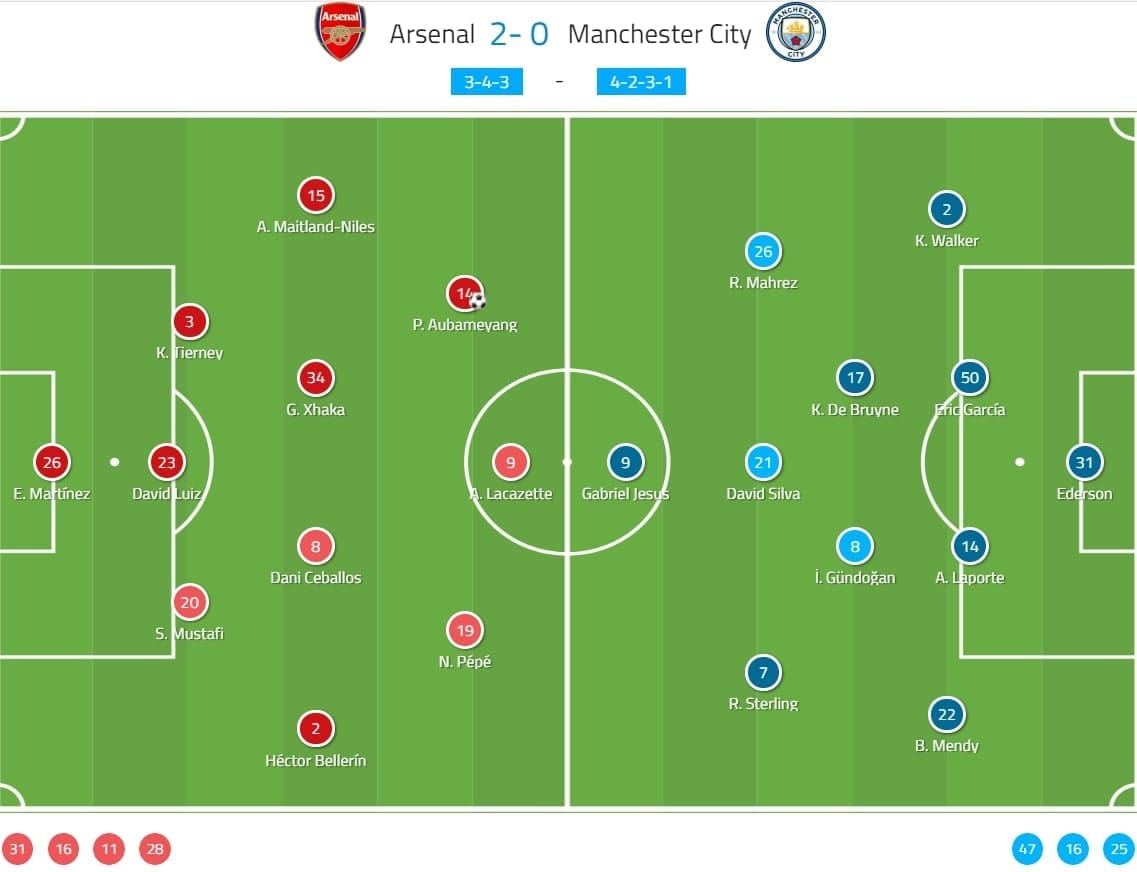
Arsenal played in a 3-4-3, but the choices of players have changed. Kieran Tierney started as the left centre-back while Sead Kolašinac stayed on the bench. Ainsley Maitland-Niles was the left wing-back. Nicolas Pépé continued to play as the right-winger and his performance was impressive!
City made huge changes compared to the Bournemouth game, playing in a 4-2-3-1. Only Kyle Walker, Benjamin Mendy, David Silva, İlkay Gündoğan and Gabriel Jesus started the previous game among the outfield players. It was a very strong lineup from Pep.
City had a poor first half
City were not really that bad, but the performance in the first 45 was not the highest standard. They suffered both offensively and defensively because of the sloppiness. During the build-up, they faced a stubborn block from Arsenal and failed to beat it effectively. Since the opponents cut the diagonal passing lanes to the wide players, the out-balls were usually vertical passes. This was suboptimal as the receiver was inevitably forced to drop with closed body shape. Raheem Sterling in the below scene is an example.
In fact, there are still weaknesses in Arsenal’s defensive scheme. For example, Héctor Bellerín was tight on Sterling and this should be a loophole to exploit. However, lacking the dynamical rotations at flanks as the City front players were pre-occupying spaces failed to expose this issue. In other words, the tempo was too slow, and the off-the-ball movements were not enough.
Sometimes City had the momentum to create something, but they never seemed to make them count. Here, Mendy was running at the wide zone when Sterling occupied Bellerín, Jesus occupied the centre-backs. Maybe a chipped ball from Laporte already helped City to enter the offensive third but the Frenchman centre-back tended to find the vertical option.
Okay, finding Sterling was not a bad option as the winger with 27 goals this season also possessed the positional superiority. He was between three defenders but failed to connect other progressive options given his body shape. It was closed and the visual information perceived was constrained at City’s half. Laying off to Gündoğan was not beating any of the lines and the attack was reorganized.
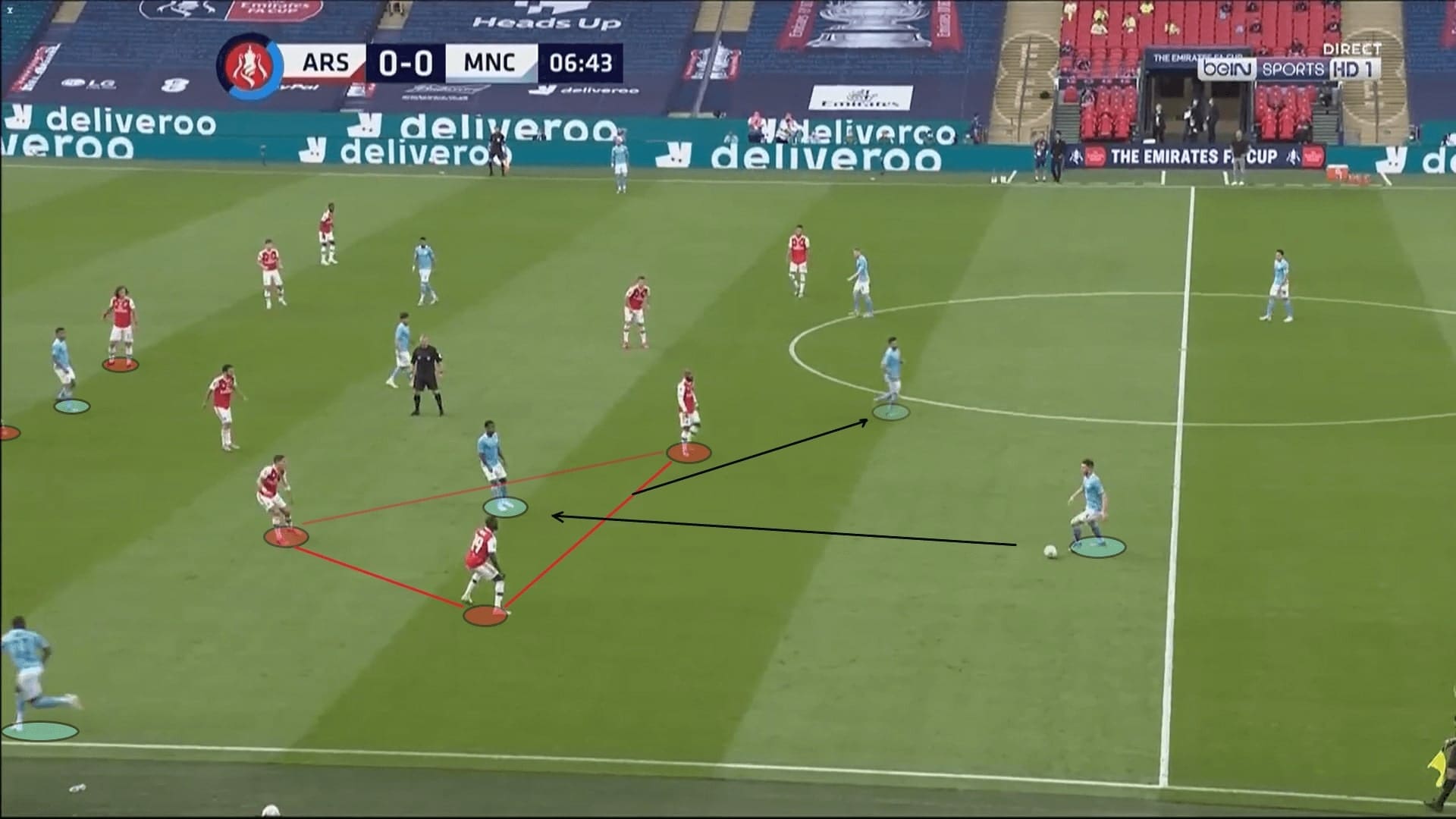
The build-up shape of City was more like a 2-2 today, this was done by dropping Kevin De Bruyne alongside Gündoğan. The approach was nothing new, have been tried before and the benefits were huge. The Belgian international was away from the marker, free to make the deep movements with dynamism and it was extremely difficult to defend. However, the Citizens failed to control the tempo and flow of the game, hence, the above scenarios seldom happened.
By using De Bruyne and Gündoğan to manipulate the Arsenal midfielders’ positions, vertical passing lanes were opened. This was vital as the connection of City centre-backs and the full-backs were cut by the wingers, so the only means to progress on the ground is this.
In this example, Pierre-Emerick Aubameyang positioned himself smartly, closing the passing lane to Walker. Meanwhile, Dani Ceballos was onto De Bruyne, the passing lane was opened. Eric García was clever to read this gap and played a vertical pass. But, as explained in the above analysis, the nature of these vertical passes hindered the angle of the receivers, which were suboptimal.
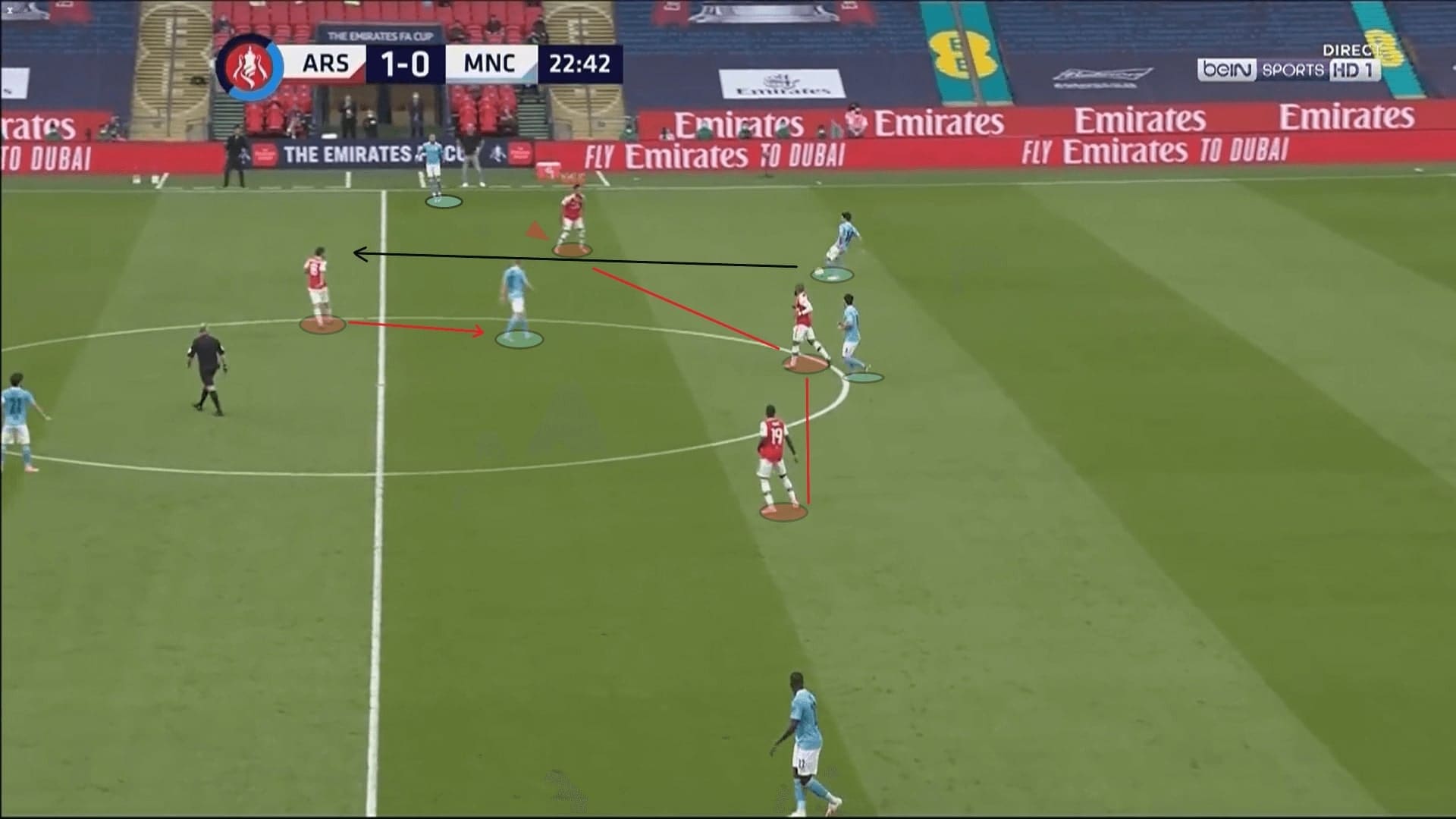
City were prone to play long, Laporte and Ederson were the main sources of the direct plays if the opponents set the block high. As mentioned, when De Bruyne and Gündoğan took the midfielders, Arsenal backline would lack protection, and this was an opportunity to attack. The Citizens placed the front three high as the targets.
City were a bit out of form, the quality of passes was not enough to make things happen. Plus, Arsenal tightly marked Sterling and Riyad Mahrez, allowing no rooms for the wingers even when the ball was controlled. Below is an example where the Algerian winger faced pressure from Tierney before adjusting the angle to dribble.
Another drawback of this setup was the offensive support. Because of the deep positionings from De Bruyne, the Belgian international was far away from the final third. In cases like this which City have bypassed the first two lines, Mahrez lacked a progressive option initially and he could only return to Walker.
Again, releasing Walker was suboptimal comparing to releasing De Bruyne. Inarguably, De Bruyne was better on the ball and this approach has put the players in suboptimal positions.
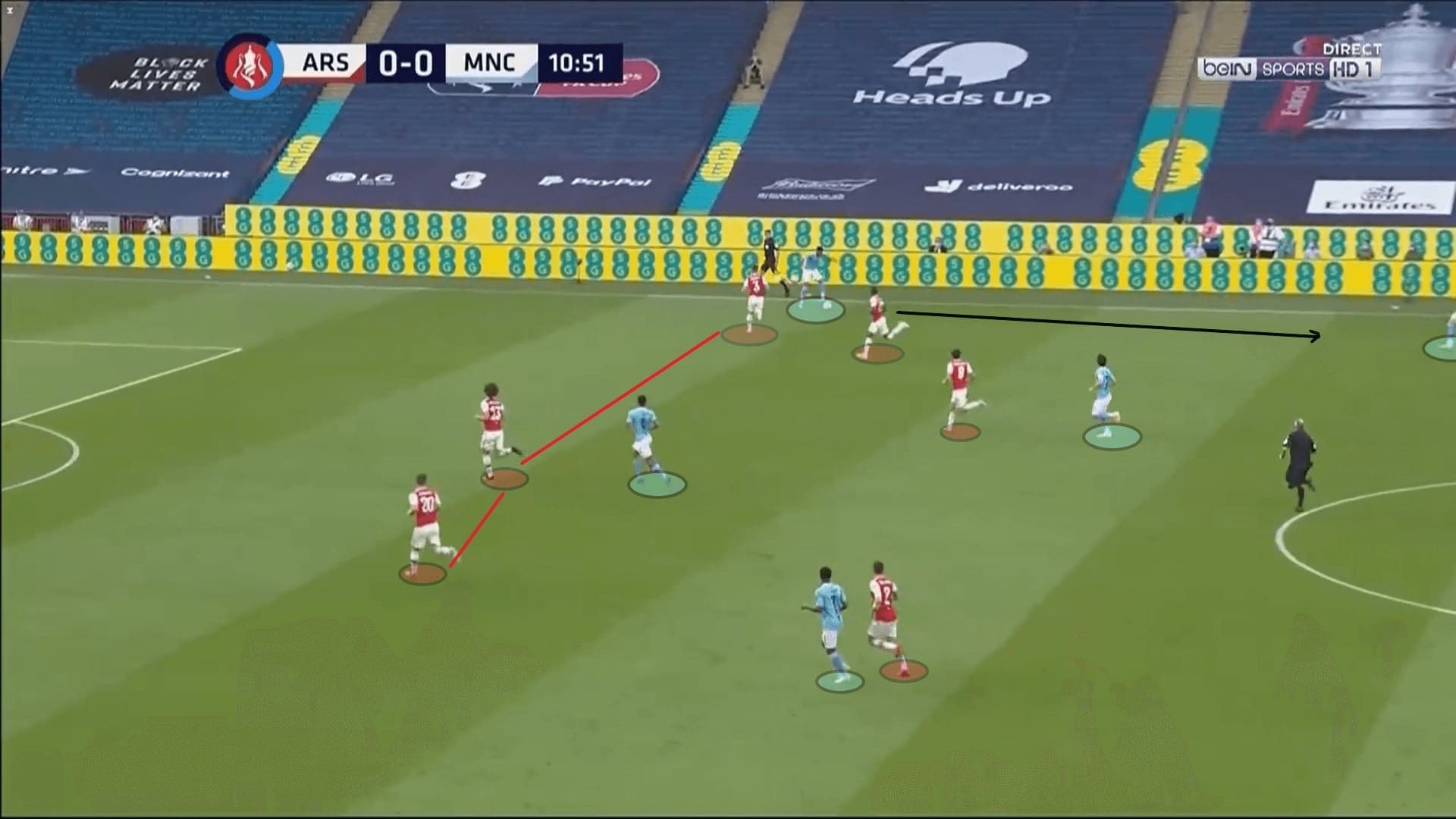
Defensively, City were pressing high to deny Arsenal’s build-up. The setup was quite fine, and the Gunners were forced to give away the ball twice in the defensive third. Nevertheless, consistency was an issue as the press only worked sometimes. The intensity was not always high, which led to the first Aubameyang goal.
In this example, City were committing numbers to press, which was roughly a 4-1-4-1 formation with Gündoğan picking the free players. The ball-side full-back was permitted to join the press and operate as a point of pressing trap on the opposition wing-backs. Most options of Shkodran Mustafi were controlled in this image, while Mendy (not in the pic) was approaching Bellerín, the Arsenal #20 panicked and lost possession. It was unbelievable that City failed to make these high presses count and punish the opponents for these errors.
Perhaps Mustafi should be targeted as the weakness to press quicker. Sterling did okay to control the German centre-back, but he needed more to force more errors in the build-up.
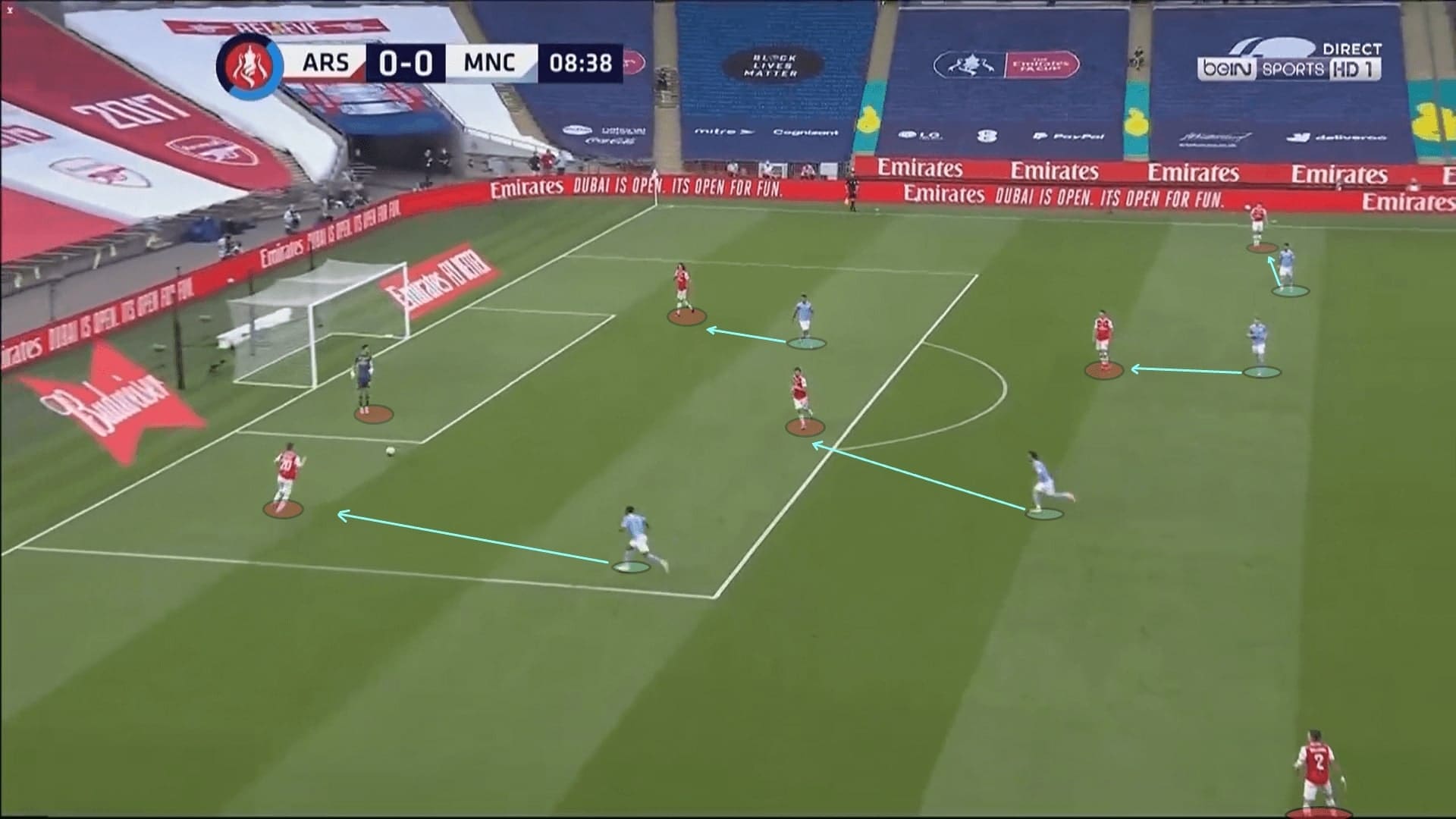
This is an example when the press has gone wrong. Arsenal improved hugely in terms of playing in tight spaces and under pressure. With Alexandre Lacazette as the striker and the flexibility of Tierney, sometimes the press of City failed to stop the build-up.
In this example, the Citizens were pressing high and the players positioned themselves quite fine – committing numbers on the ball-side and the far-side winger: Sterling came inside to maintain the compactness. But, Arsenal were well-prepared by moving Tierney as a left-back, dropping Lacazette as the extra man an overloaded Gündoğan.
The issues are different from different aspects. Firstly, Mahrez was not pressuring the ball enough and allowed Ceballos to play the out-ball. From a collective perspective, the underload on Gündoğan was a structural issue. The German international was more focused on the Frenchman striker and leaving the passing lane to Maitland-Niles opened. Better communication with teammates is needed. Consequently, the shadowing efforts of De Bruyne were in vain as Tierney was found in this third man play eventually.
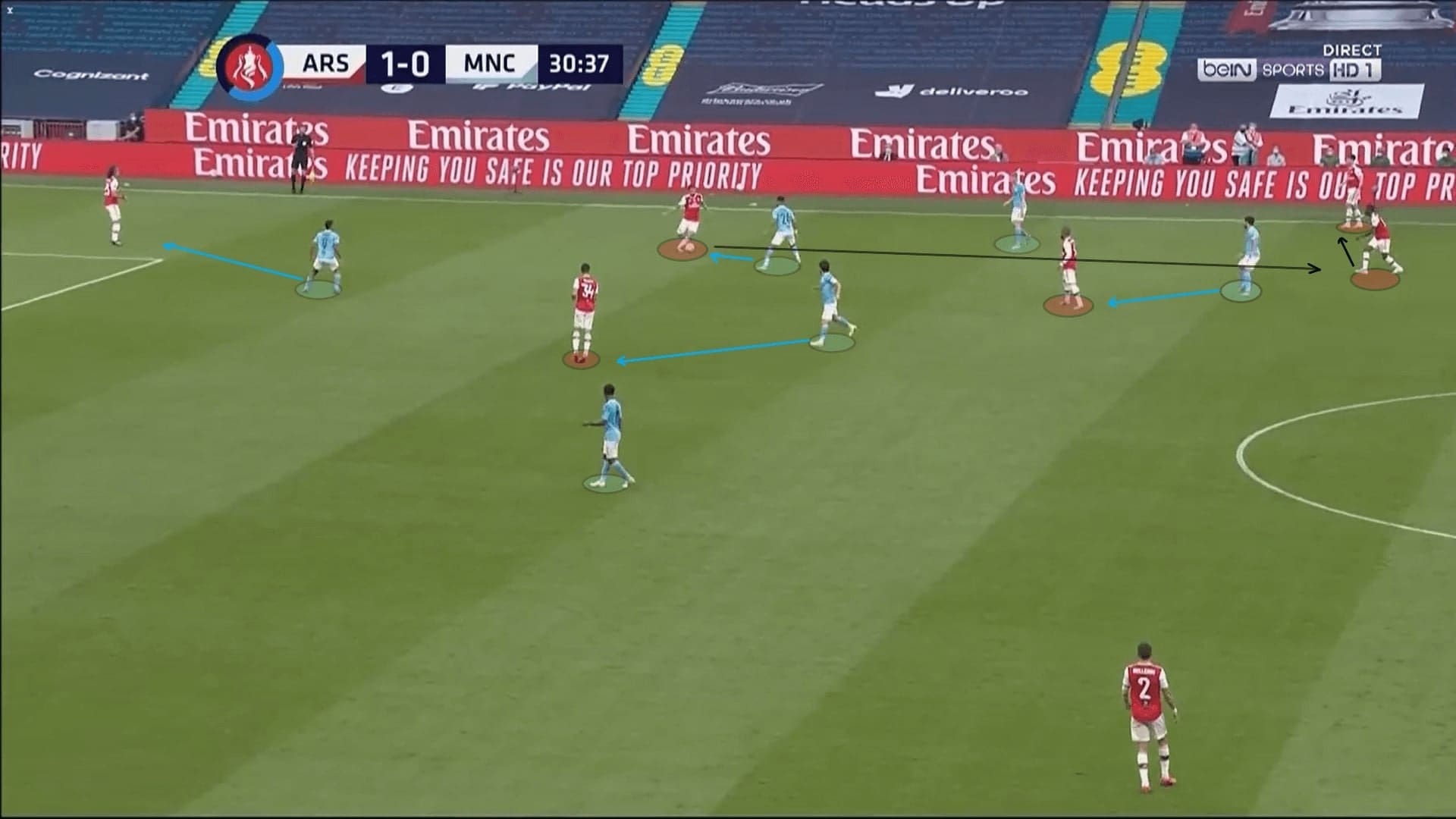
Arsenal defensive style of play
Arteta was very clever to set the defence against City. Again, the head coach understands the limitations of Arsenal players and the insufficient time for training. Therefore, a deep block was set instead, and it was very difficult to beat. In this game, the defensive performance of the team improved a lot, from the individual levels to a collective level. The efforts were rewarded!
In this recoveries graph of Arsenal, we want to show you the areas where the team were regaining the ball. Only 6% and 14% of them came from the offensive third and central third. An incredible of 80% recoveries were recorded in the defensive third. This has matched the above words that “Arsenal set a deep block”.
Also, looking at the top players with most recoveries, we understood the pattern more. Unsurprisingly, the back five were on the list and the exception case was Pépé, whose performance was tremendous in this game.
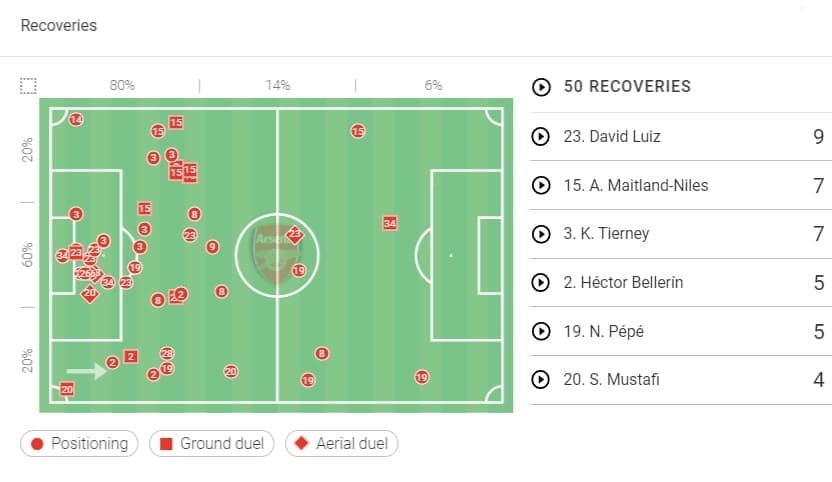
During the City build-up, Arsenal positioned the backline deep to avoid the likes of Jesus and Sterling from running behind. The other five were committed to defending the opposition, but an issue was only playing two midfielders was an underload to City’s midfield trio. This was solved by dropping Lacazette as another player at the midfield. Now, the 3 v 3 numerical equality was reached, and the free man was not available at the midfield.
Arteta also understood the capability of Mendy, as well as Walker at flanks. To prevent the wide players were found by the diagonal balls, the Arsenal wingers tried hard to cover the passing lanes and forced the play central. Or, this was even done at the expense of leaving the vertical passing lanes opened. As a reference, notice the body orientations of Aubameyang and Pépé below, both have kept Walker and Mendy covered.
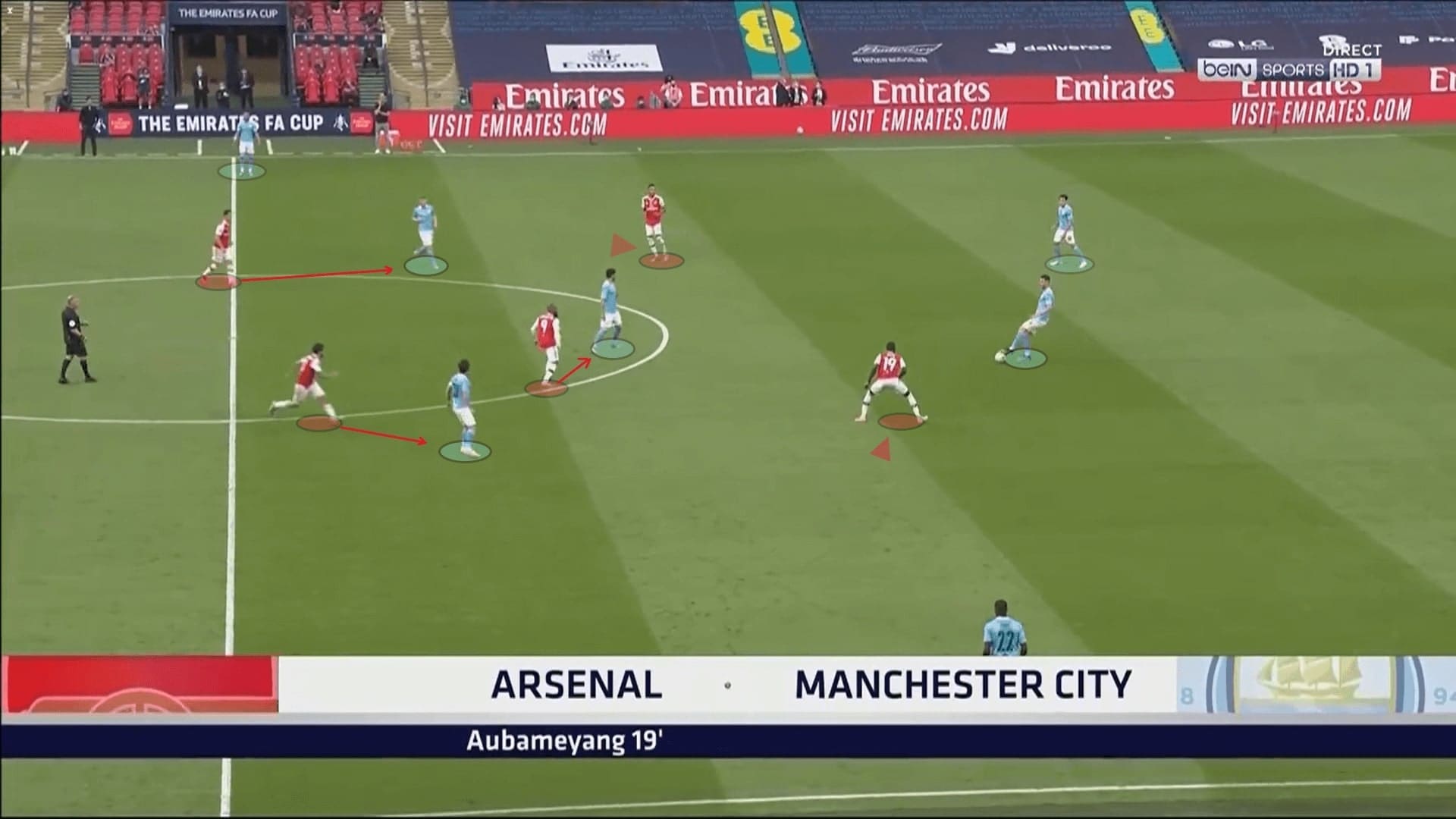
Football is a team sport. The players had to defend as a team to make the block solid. Sometimes Granit Xhaka and Ceballos were deeper as they were not needed – the wingers would cover the central option. In this example, Lacazette and Aubameyang were marking De Bruyne and Gündoğan. This means the midfield duo could shift to other targets and protect spaces. Sometimes Bellerín also jointed the press to approach Mendy but more often he was tasked to mark Sterling tightly.
This means the City centre-backs were seldom pressured as Lacazette was defending deep. If the high pressing were initiated, the lead would be either winger such as Pépé in this scenario. The Ivorian player has improved a lot defensively. Under Arteta, he learnt to curve his run during the press, which was extremely useful to cover the left-back. In this example, the passing lane to Mendy was covered during the curve run and Laporte was forced to carry the ball forward, given Pépé at his back.
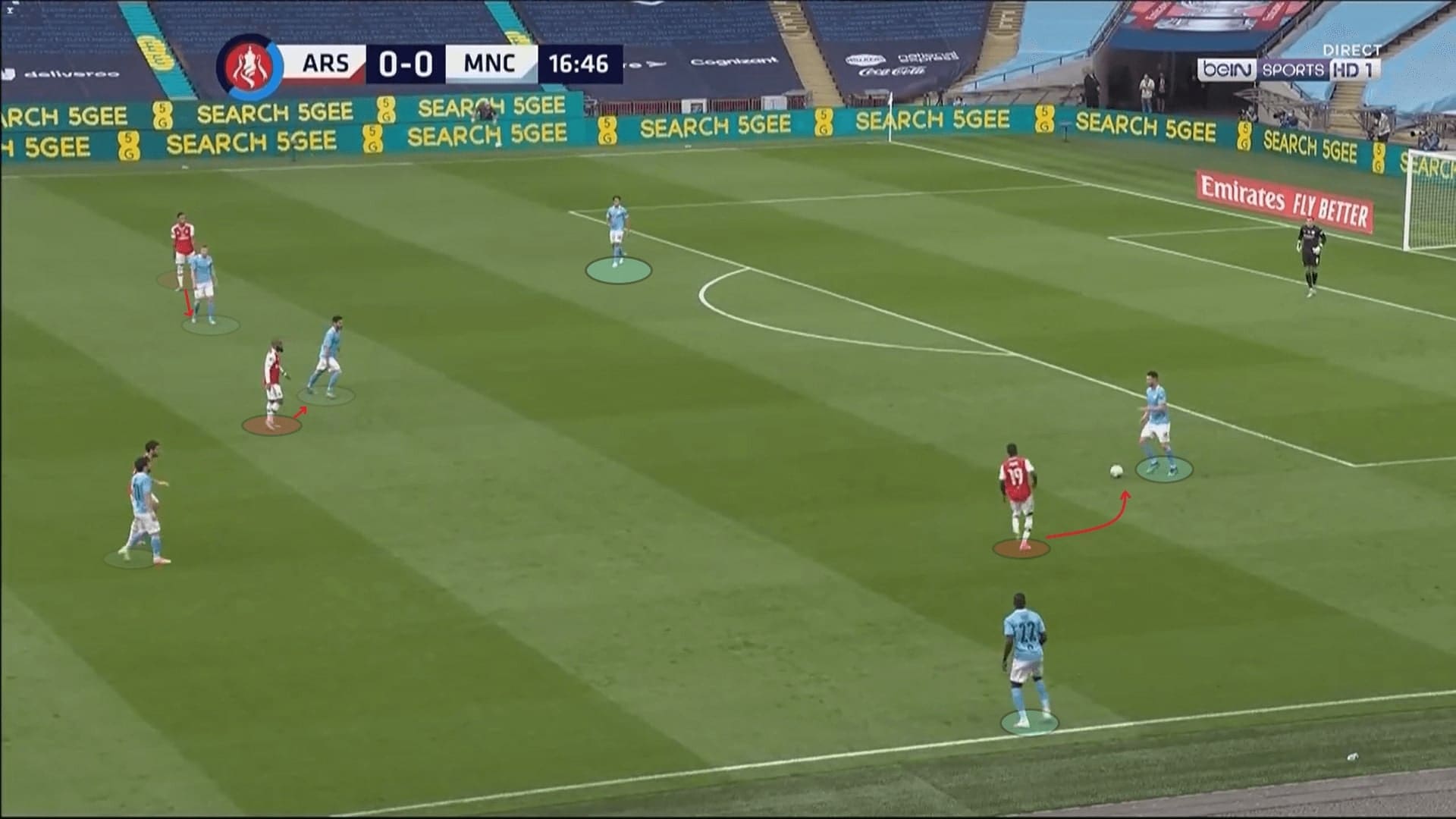
Even when City progressed, they could not capitalise on Mendy’s offensive contribution because Pépé has committed himself defensively. The winger often dropped to the same line with the midfield, protecting the areas on the left. Therefore, the midfield duo could stay centrally to shield zone 14.
This was important to prevent Bellerín facing Sterling and Mendy at the same time. Also, this avoided Mustafi being exposed in the 1 v 1 situations – which was optimal as the German centre-back only had to defend the zone.
These setups were illustrated with this image. Bellerín was facing Sterling 1 v 1 but having Mustafi as a defensive cover. Pépé was staying deep to contain Mendy, allowing Xhaka and Ceballos stayed at the centre.
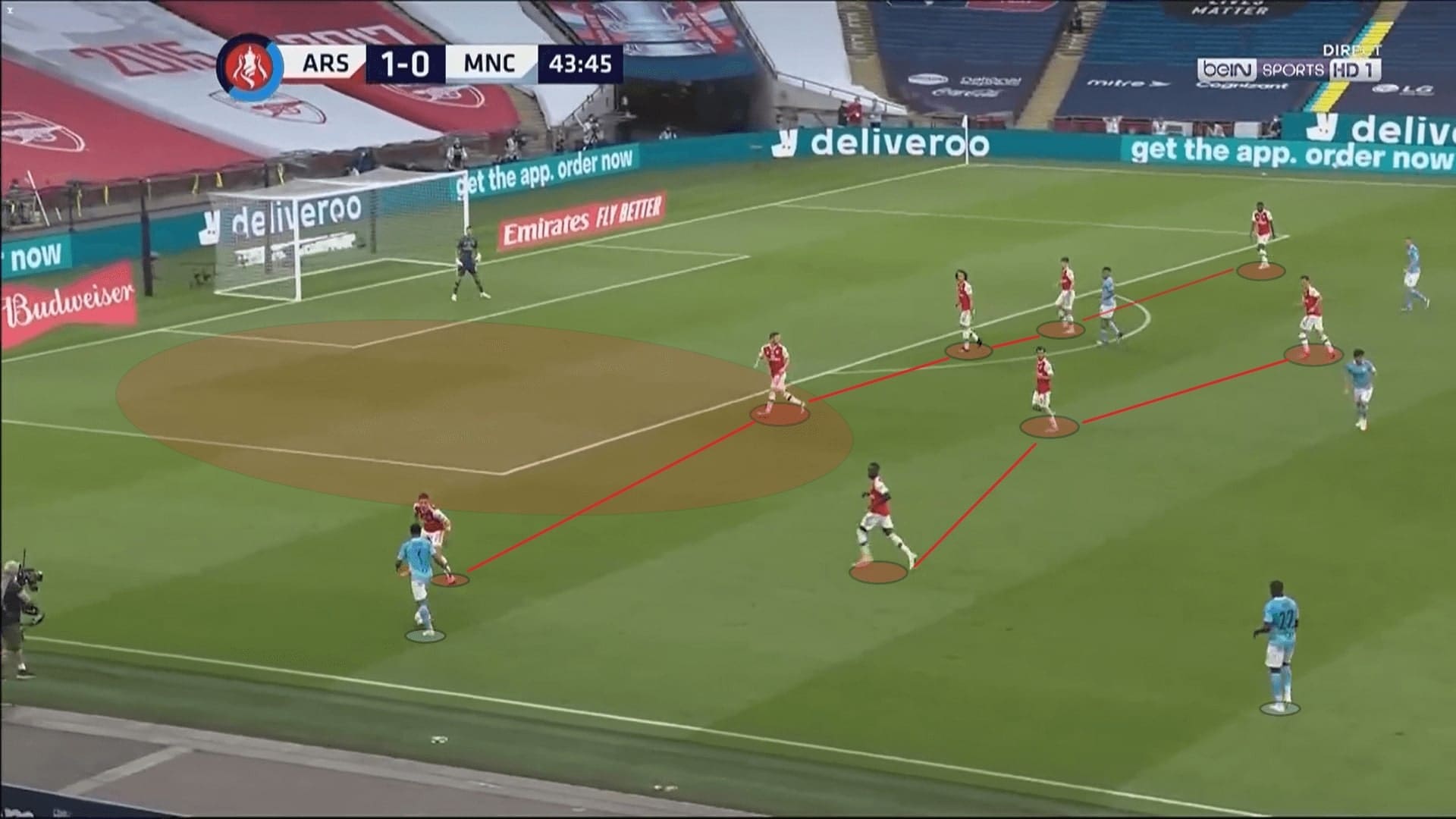
Tactical tweaks of Pep
Pep had to change something, as the tactics in the first half were not too successful. Some players were playing poor such as Walker, who failed to provide anything from an offensive point of view. The 2-2 build-up was not helping the team to dictate the tempo and the Citizens were yet to register a shot on target.
In the second half, De Bruyne was pushed forward as a partner of D. Silva. Both advanced midfielders stayed higher and between the lines. The centre-backs were tasked to carry the ball forward and ideally, play the out-ball to the free player. This was easier to execute as we have mentioned in the above analysis, Arsenal seldom pressed the centre-backs.
In this example, Laporte did a good job to carry the ball forward. The Frenchman defender managed to find De Bruyne although the passing lane was narrow. Also, this was a diagonal pass, which means the receiver was in a better body shape. This has helped De Bruyne to execute his next move quicker and found Mahrez, who often utilized his qualitative superiority against the right wing-back in the second half.
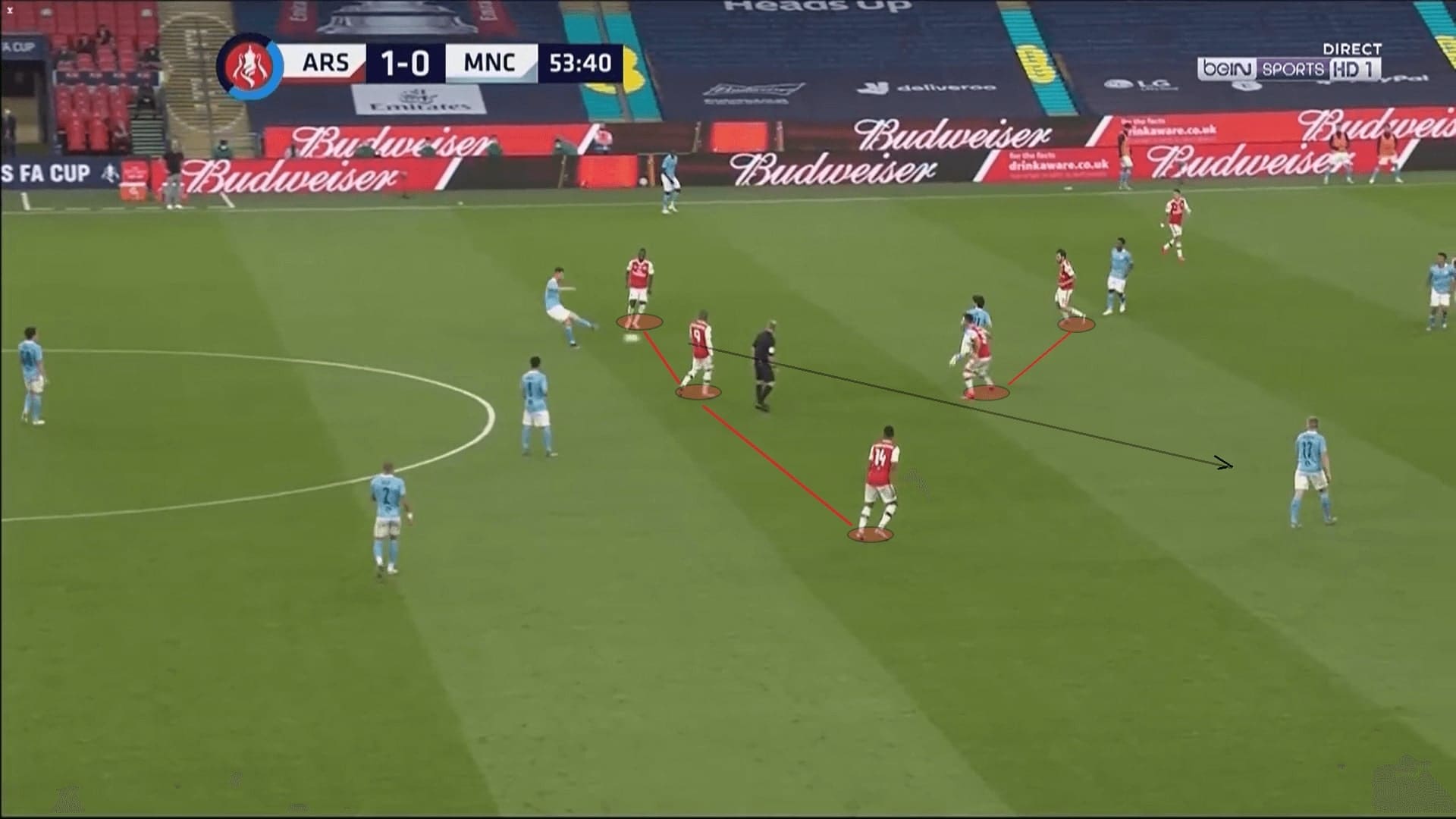
Meanwhile, D. Silva also operated between the lines more often. This was conducive to the attack as the El Mago could connect the players. The City #21 was undoubtedly the best in the world in terms of playing in tight spaces, playing the through balls. Through the duo of D. Silva and De Bruyne, City managed to play some through passes to release the front players near the penalty box.
Here, Gündoğan exercised his exceptional passing skill to find D. Silva, who was moving between the lines. The Spaniard was quick enough to pick Sterling behind the line. If not Arsenal’s close proximity in the defence, the English international would have equalised for the team.
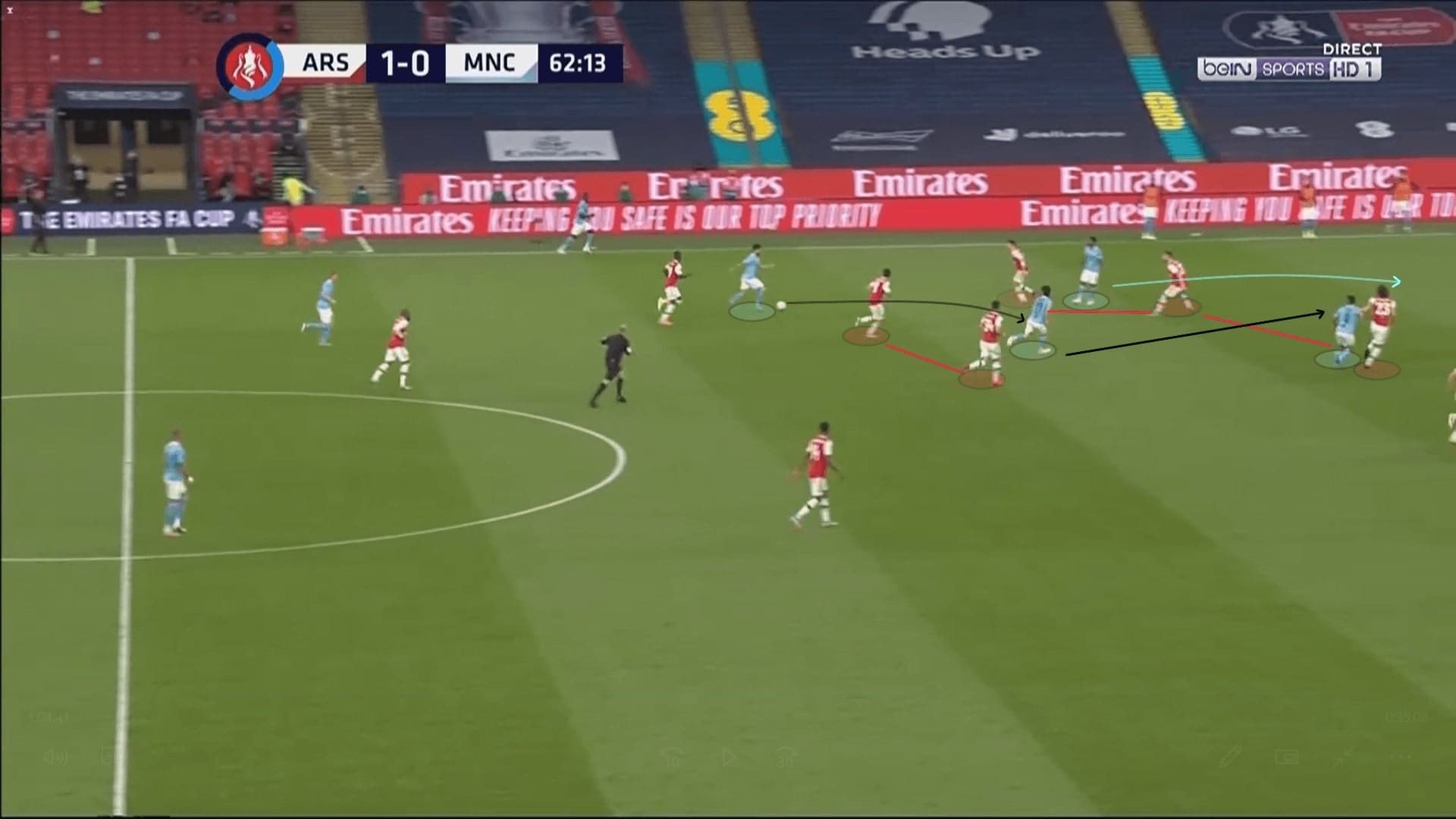
Credit should be given to Arteta and the Gunners. Comparing to the first half, Arsenal were a lot more defensive, just like parking a bus and getting everyone behind the ball. Even sometimes the shape was stretched in the transitions, the midfielders were aware of covering spaces in the penalty box.
As a result of Laporte’s through ball, Sterling received the ball behind the defence and David Luiz was pulled wide. It was a dangerous situation as Jesus possessed the dynamic superiority against Tierney, ready to attack the box. He was likely to meet Sterling’s cross. However, Ceballos and Mustafi were extremely disciplined to cover the opened spaces and blocked cross, incredible awareness and work rate even at the 74th minute.
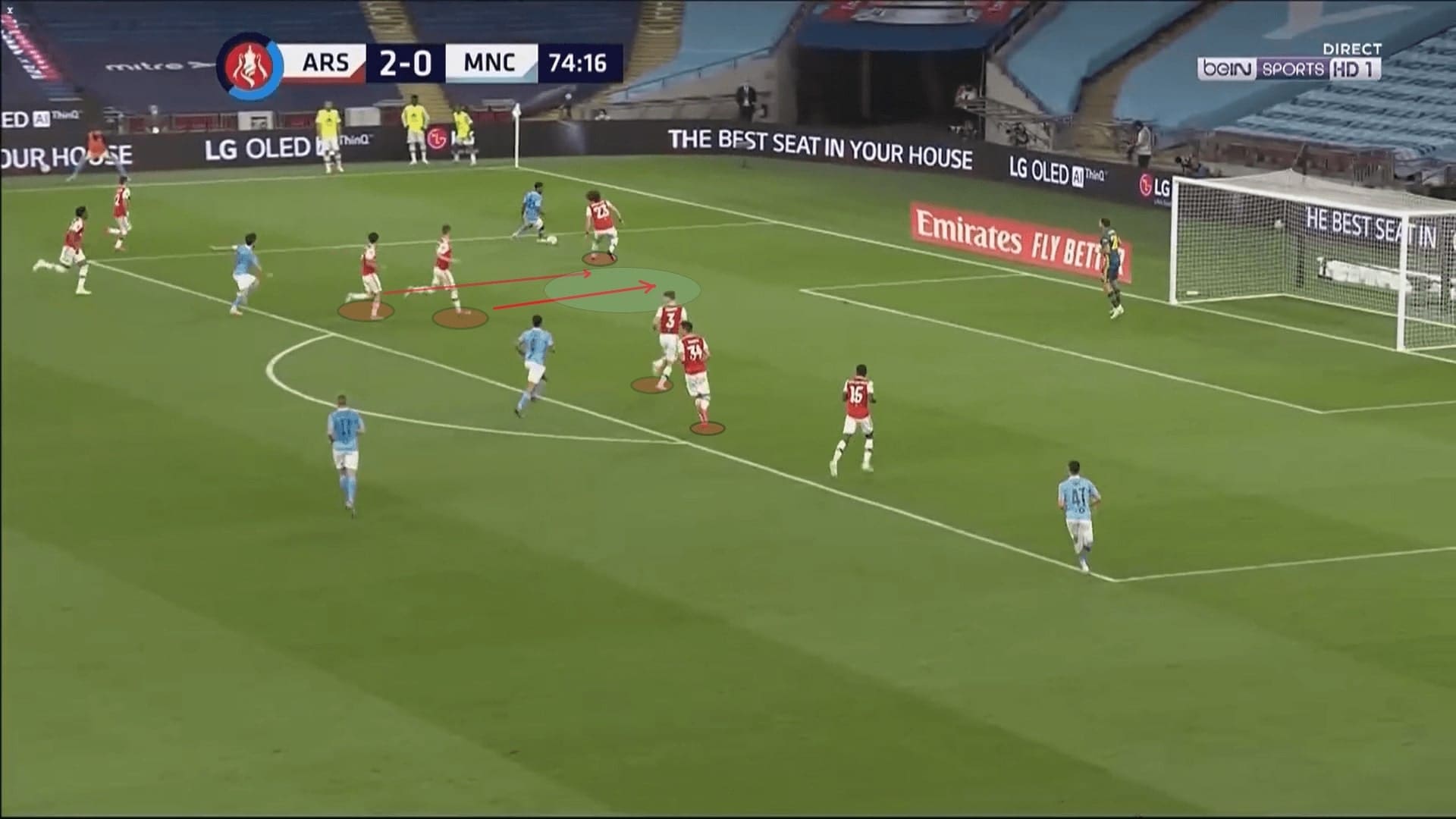
We are not illustrating how Arsenal set the defence or the shape. Basically, the tactic was to put every man behind the ball, overloading the central spaces. This would force City to play around the block because it was impossible to penetrate at the centre. When the crosses came in, block it.
Here, Phil Foden had one second staying between the lines, but soon spaces were closed by Joe Willock and Aubameyang. It was incredible, note how the 10 Gunners stayed in front of Foden and at the centre. No rooms for long-ranged efforts in zone 14. The wide option, Mendy was available and the only viable option, Foden passed him the ball and you know the results.
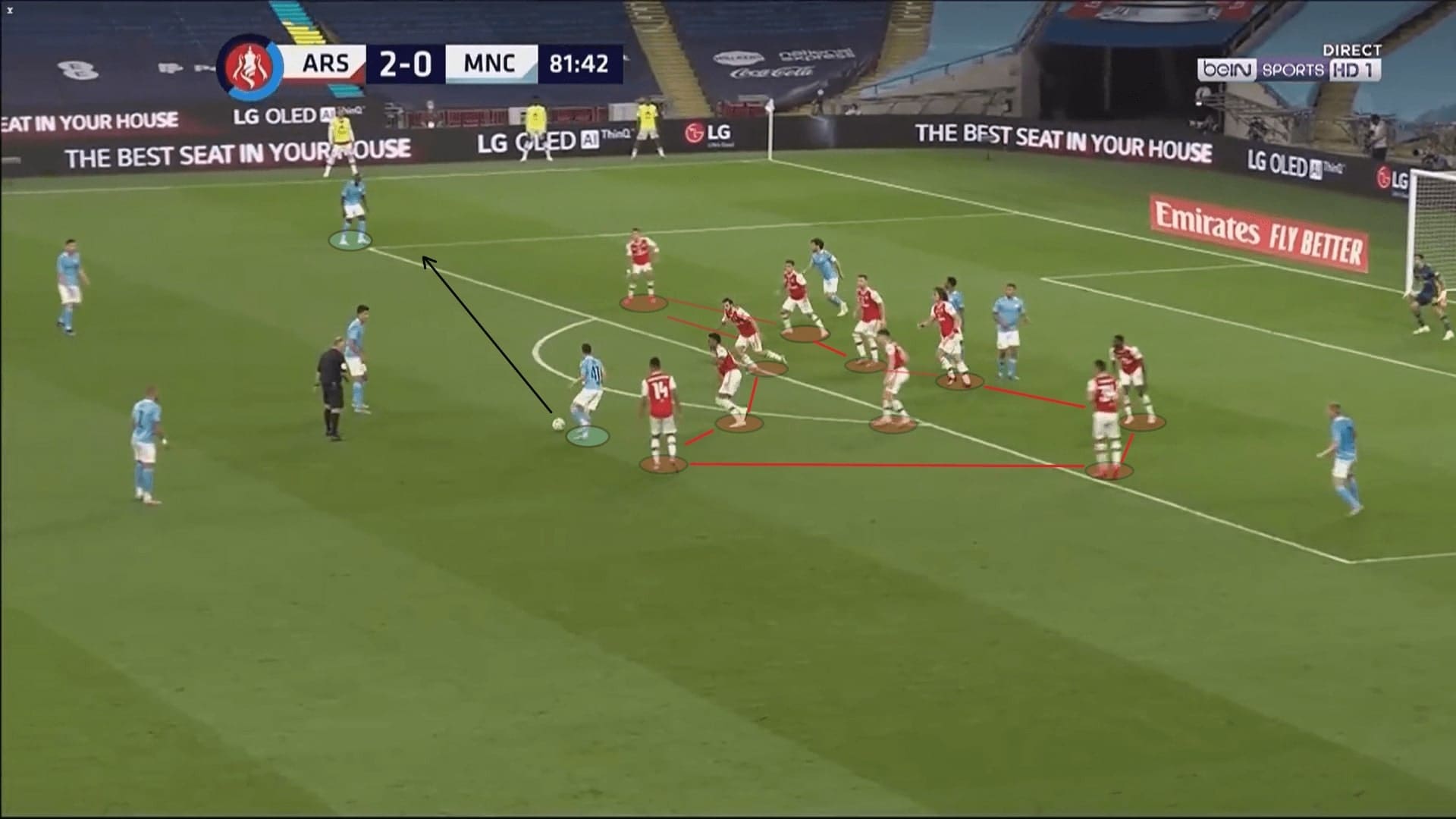
Throughout the game, the Arsenal defence was so difficult to break. Luiz, Mustafi and Tierney extremely focused on the game, clearing most dangerous crosses in the box. The anticipations, judgements and executions were great, they always reached the ball before a City player. Quite a lot of corners were conceded but City never looked like going to score from a corner – Laporte was the main man but seldom had the chance to attack free spaces.
Below is a crossing map of City. The success rate of 35 crosses was not bad, 31.43% accuracy was near the season average 32.5%. However, some were recorded as a successful trial because it was over the penalty area, the current figure was a bit higher than the actual performance. Although good chances were created by the crosses, such as D. Silva’s 0.42 xG shot, but City failed to convert the chances into some goals.
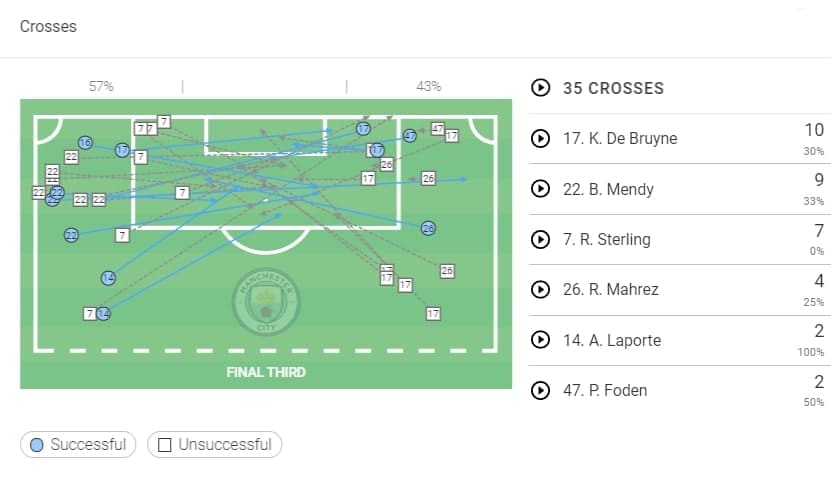
Transitions phases
So, why did Guardiola play De Bruyne alongside Gündoğan? This was because of the control in the transitions. Using the inverted full-backs was okay, but their passing quality and composure on the ball was nowhere near to De Bruyne. Remember Oleksandr Zinchenko’s error against Southampton? This was how the goal was conceded. Looking back to the recovery graph of Arsenal, this tactic was successful as City seldom gave away the ball in the central third.
Defensively, the full-backs were better but it was a bit risky to instruct multiple duties. Guardiola did not want to leave Aubameyang unmarked in the offensive transitions. This was the reason of Walker operating as a tradition right-back in the first half.
In this example, the benefits of using a double-pivot was shown by the defensive positionings. At the moment City which lost the ball, two were behind the Arsenal players and available to control both Lacazette and Aubameyang. For Pépé, it required time to join the attack as he was battling with Mendy all the time.
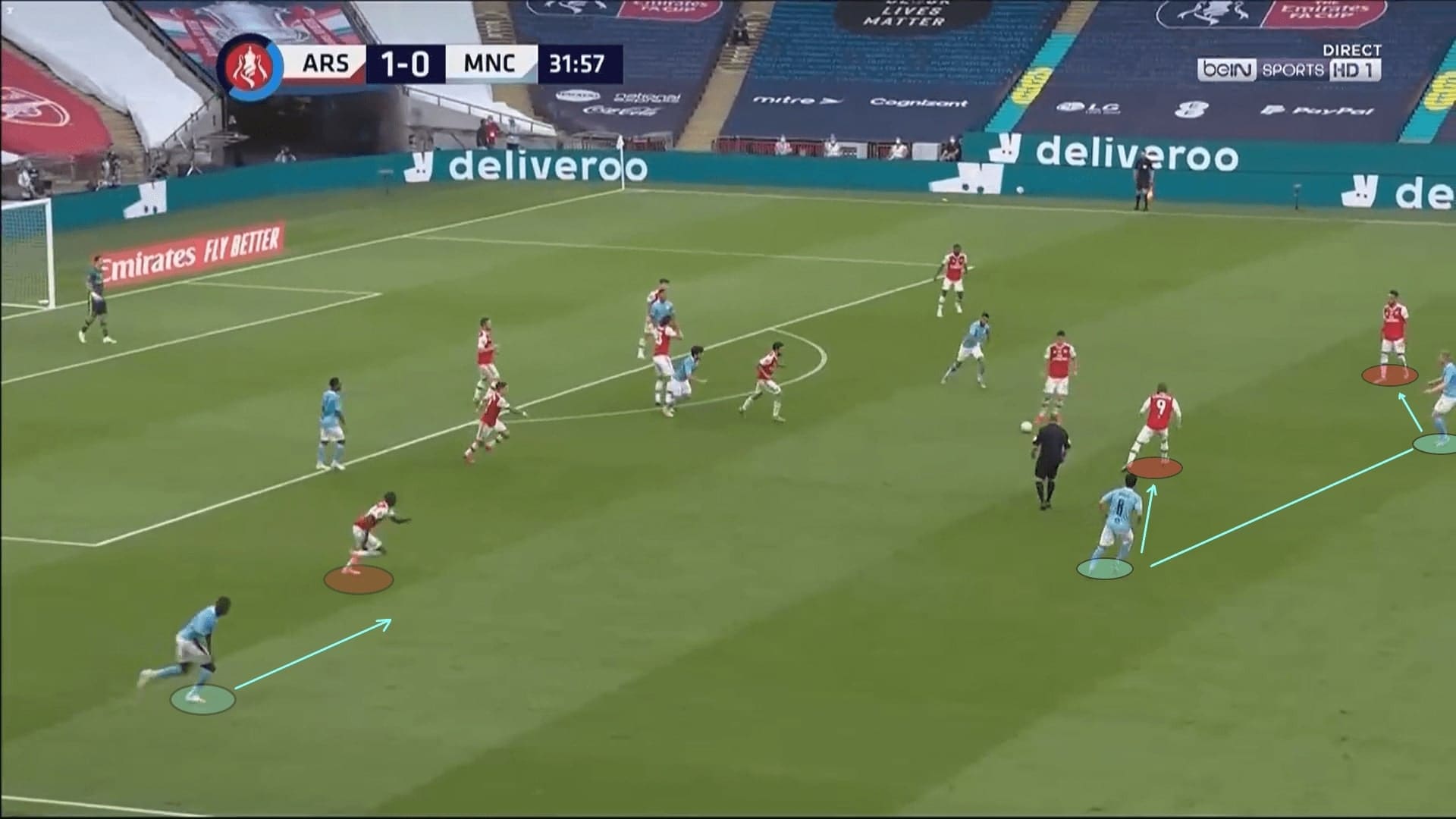
For Arsenal, Lacazette is a much better option than Eddie Nketiah in the offensive transitions. The former Lyon striker was good at using his body to separate the ball and the opponent, serving as a target on these occasions. In some better cases, Lacazette could even distribute the ball to the weak flank where Aubameyang and Pépé could function the qualitative superiority.
In this example, García pressured from Lacazette’s back immediately. The Arsenal #9 did well to return the ball to Xhaka, who had a good body angle to release other options. By “other options”, we are referring the wingers who always made the forward runs. Sometimes they were even supported by the wing-backs – Maitland-Niles overlapped to help Aubameyang.
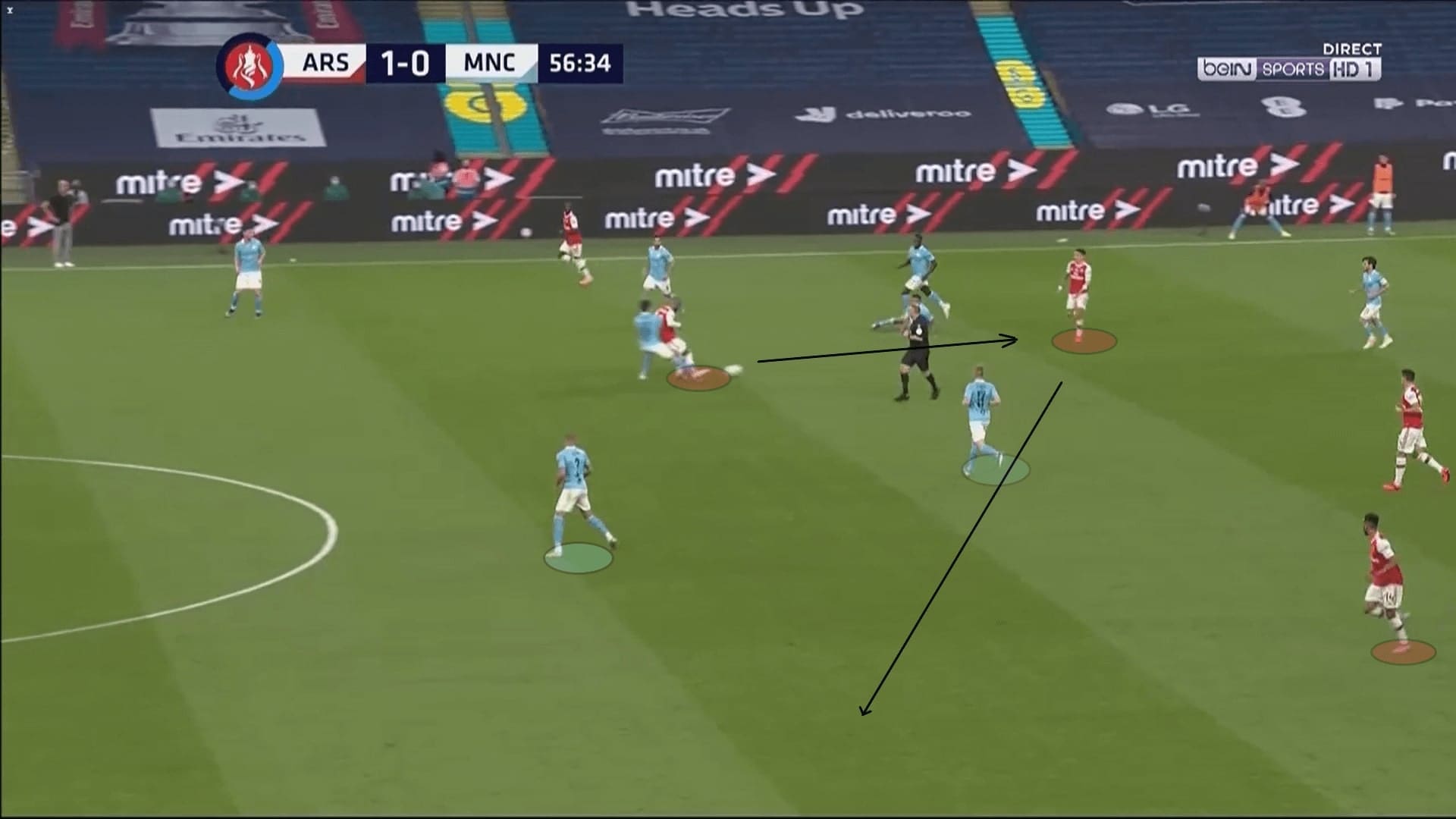
In fact, City also had their moments to create something in the counter-attacks. However, even the likes of De Bruyne could dribble past some midfielders, attacking the backline, the decisions and executions were not up to standard.
Mahrez was the player leading this counter-attack. Two options were available, and this was a good moment to release Sterling. Luiz already positioned himself wrongly, the City #7 should be able to meet the pass. However, the Algerian winger tried to be clever, playing to Jesus instead of areas filled with City players. The opportunity was ruined.
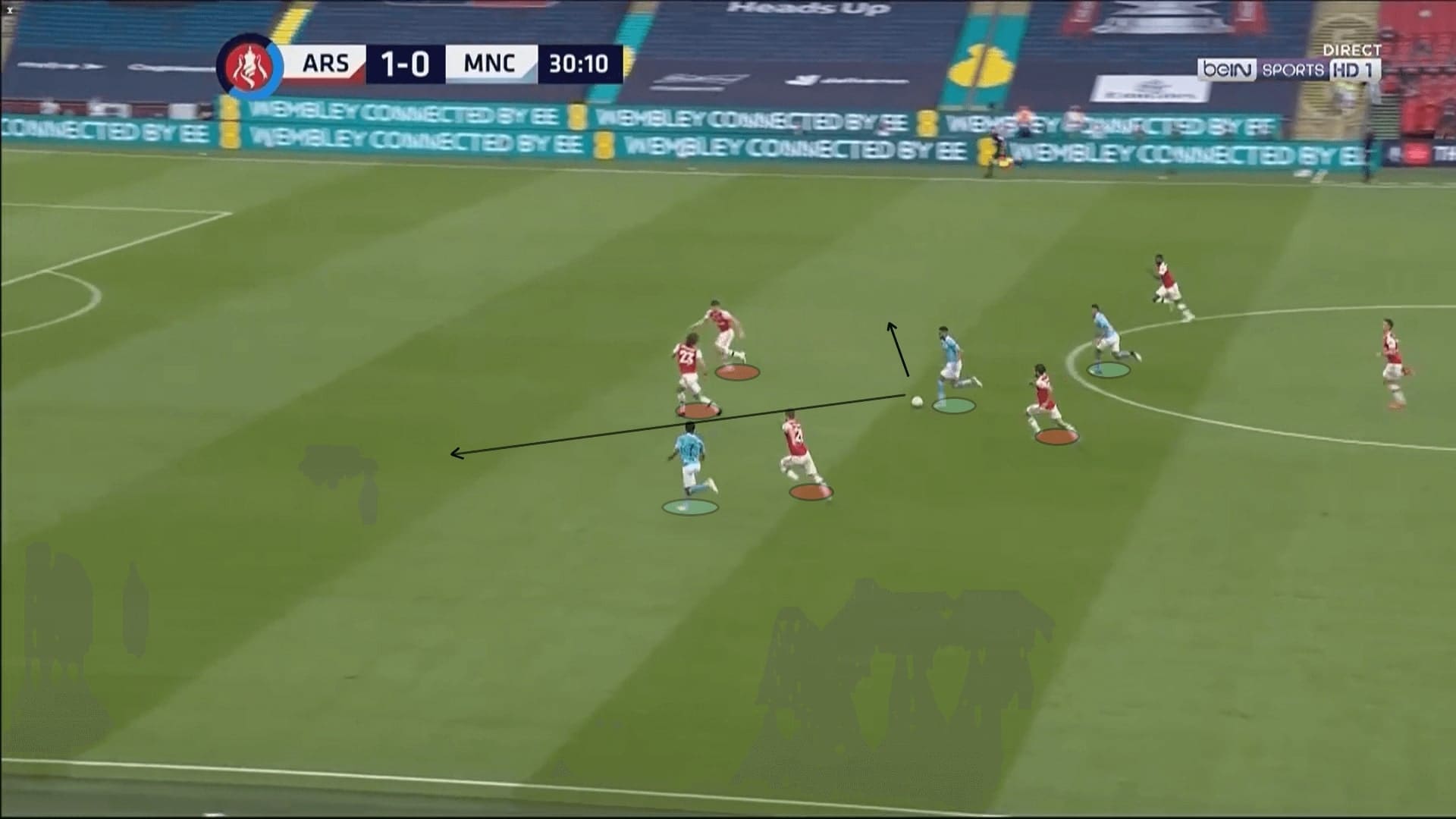
Final remarks
It is another classic City lost in this season – having more shots (16-4), possession (70.92%-29.08%) and even xG (1.91-1) but these were not converted to goals. A mix of player mentality and tactics were the issues and as Pep said, “it doesn’t take a genius to realize we need to raise our level against Real Madrid”. Two weeks to go for another big clash, will City manage to bounce back? We will see.
Arsenal had a decent game in general, also a bit of luck as none of the sloppy mistakes were punished by the opponents. Aubameyang has proven the quality again, what a deadly striker who could finish difficult chances. This was a huge victory to the Gunners and they now marched into the final, the 21st time in team’s history.




Comments